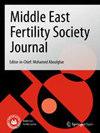Embryo response to aneuploidy through self-correction mechanism: a literature review
IF 1.3
Q4 REPRODUCTIVE BIOLOGY
引用次数: 0
Abstract
Meiotic and mitotic errors often lead to aneuploidy and mosaicism. In this context, the self-correction mechanism enables the embryo to preferentially retain and preserve euploid cells through processes such as apoptosis, necrosis, or marginalization. This mechanism is thought to minimize the chance of genetic abnormalities during cell development. A literature search for articles written in English from January 2013 to October 2023 was conducted on PubMed, EBSCO, and Scopus, using the keywords “self-correction,” “self-repair,” “aneuploidy,” “mosaicism,” and “embryo.” A total of 308 articles were collected, out of which 5 retrospective and 1 prospective study were selected based on inclusion criteria. Investigations showed that embryos remove chromosomally abnormal cells, supporting the self-correction mechanism. aCGH has been used in 4 studies to demonstrate the presence of self-correction in mosaic embryos. Furthermore, a higher relative viability of polyploidies than complex aneuploidies was observed, suggesting early discrimination against complex aneuploidy, particularly those arising from mitotic origins. However, there are doubts about the reliability of preimplantation genetic testing for aneuploidy at the blastocyst stage, as it may lead to a high rate of false positives and the discarding of "good" embryos. Studies showed a self-correction mechanism in human embryos through the ability to expel abnormal cells. Further investigation is needed to elucidate the underlying mechanisms and determine optimal strategies for preimplantation genetic testing to fully understand and optimize the use of self-correction mechanisms in embryo assessment and selection.胚胎通过自我纠正机制应对非整倍体:文献综述
减数分裂和有丝分裂错误往往会导致非整倍体和嵌合。在这种情况下,自我校正机制可使胚胎通过凋亡、坏死或边缘化等过程优先保留和保存单倍体细胞。这种机制被认为能将细胞发育过程中出现遗传异常的几率降至最低。我们在 PubMed、EBSCO 和 Scopus 上以 "自我校正"、"自我修复"、"非整倍体"、"镶嵌 "和 "胚胎 "为关键词对 2013 年 1 月至 2023 年 10 月期间的英文文章进行了文献检索。共收集到 308 篇文章,根据纳入标准从中筛选出 5 项回顾性研究和 1 项前瞻性研究。调查显示,胚胎会清除染色体异常的细胞,这支持了自我校正机制。有 4 项研究利用 aCGH 证明了马赛克胚胎中存在自我校正。此外,还观察到多倍体的相对存活率高于复杂非整倍体,这表明早期对复杂非整倍体(尤其是有丝分裂起源的非整倍体)进行了区分。然而,在胚泡阶段进行植入前非整倍体基因检测的可靠性还存在疑问,因为这可能会导致高假阳性率和 "好 "胚胎被丢弃。研究表明,人类胚胎具有自我校正机制,能够排出异常细胞。为充分了解和优化胚胎评估和选择中自我校正机制的使用,需要进一步调查以阐明其基本机制,并确定植入前基因检测的最佳策略。
本文章由计算机程序翻译,如有差异,请以英文原文为准。
求助全文
约1分钟内获得全文
求助全文
来源期刊

Middle East Fertility Society Journal
REPRODUCTIVE BIOLOGY-
CiteScore
2.80
自引率
0.00%
发文量
32
审稿时长
45 weeks
 求助内容:
求助内容: 应助结果提醒方式:
应助结果提醒方式:


